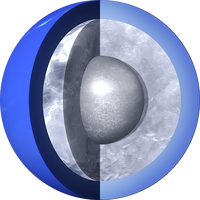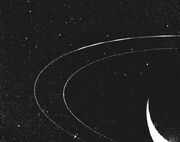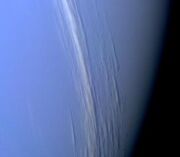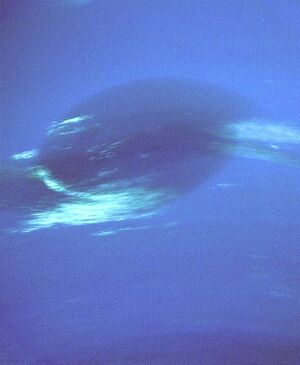Neptune is the eighth and furthest planet from the Sun. Neptune is an ice giant like Uranus and was discovered on September 23, 1846 by three astronomers: John Couch Adams, Urbain Le Verrier, and Johann Galle. Neptune has 16 known satellites. Its biggest moon is Triton and its smallest and most distant is S/2021 N 1.
Neptune is famous for having the fastest wind currents in the entire Solar System, speeding up at a velocity of 1200 miles per hour/1900 kilometers per hour.
Formation
Neptune's core formed from a clump of rocky material that was around 2 ~ 5 times in Earth's mass. Its core gathered enough gas to become a Jovian, ice giant planet.

Composition
Neptune's atmosphere is composed of the same materials as Uranus, methane and ammonia, with small amounts of ice in its atmosphere and its core composed of mostly metallic materials and rock.
Because Neptune and Uranus are so similar, they have been categorized separately. Neptune and Uranus have been categorized using the term "ice giant" due to there being an exceptional amount of cryogenic compounds of carbon and ammonia in the atmosphere, which can lead to frozen water in the atmosphere and the surface.
Internal Structure
The internal structure of Neptune is similar to that of the neighboring planet of Uranus. The first layer is the mantle, which makes up the mass of Neptune. The mantle consists of a water-ammonia compound and methane. In fact, the water-ammonia compound makes up so much of the mantle, scientists refer to it as a water-ammonia ocean. The core of Neptune is mostly made up rock silicates such as iron and nickel.

Rings
Neptune has its own collection of rings called the Rings of Neptune. These rings were discovered in the La Silla Observatory in Chile by Reinhold Häfner, Patrice Bouchet, and Jean Manfred. These rings very lowly dense. Even at their densest, they are only as dense as the lesser dense parts of Saturn's rings. The innermost moons in the rings include Despina, Naiad, Thalassa, and Galatea.
Orbit and Rotation
Neptune makes only one orbit around the Sun in about 164.8 earth years. This is because Neptune is more than three billion miles from the Sun.
Because of its gaseous nature, Neptune's equatorial rotation is equal to 18 Earth hours, yet since the wind speeds towards the poles are faster. Its polar rotation is equal to 12 Earth hours.

A high resolution color image, taken 2 hours before Voyager 2’s closest approach, provides obvious evidence of vertical relief in Neptune's bright cloud streaks.
Atmosphere
Most of the atmosphere of Neptune is made up of hydrogen, making up more than eighty percent of the atmosphere. The rest is made of helium, methane, hydrogen deuteride, and ethane.
Great Dark Spot

The Great Dark Spot
The Great Dark Spot, is a dark spot on the surface of the planet, Neptune. This one has many similar characteristics to the more famous, and commonly mistaken for, Great Red Spot. One example of a similarity is the category of the storm, for they are both anticyclonic storms, or storms that rotate different directions than that of regular storms, which are referred to as cyclonic. The first spot was observed by the Voyager 2 probe in 1989. The interior of these spots are cloud-free compared to that of Jupiter's Great Red Spot, which densely packed with dust-filled clouds. Winds in this storm are the fastest in the Solar System, being 1500 miles per hour.
Dimensions
The dimensions of the GDS were estimated by scientists in 1995. The dimensions measured were 15,900 x 9870 x 8350 x 4100 miles.
Disappearance
In November of 1994, the Hubble Space Telescope failed to photograph the GDS, leading scientists to believe that it disappeared. Many theories surround this disappearance - one such theory claiming that due to the high wind speeds of the cyclones, as well as their close proximity to one another, the storms all pushed themselves into different directions.
The Northern Great Dark Spot
After the disappearance of the main Great Dark Spot, a new, similar spot formed the northern hemisphere of Neptune. It was given the name of "Northern Great Dark Spot", or NGDS. It is the last major storm remaining, and has lasted several years.
Gallery
See Also
| The Planets and Dwarf Planets | |
|---|---|
| Planets | |
| Mercury • Venus • Earth • Mars • Jupiter • Saturn • Uranus • Neptune | |
| Dwarf Planets | |
| Ceres • Pluto • Haumea • Makemake • Quaoar • Eris | |
| Moons of Neptune | |
|---|---|
| Inner | Naiad • Thalassa • Despina • Galatea • Larissa • Hippocamp • Proteus |
| Triton | Triton |
| Ungrouped | Halimede • Nereid |
| Sao Group | Sao • Laomedeia • S/2002 N 5 |
| Neso Group | Psamathe • Neso • S/2021 N 1 |
